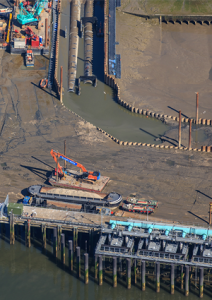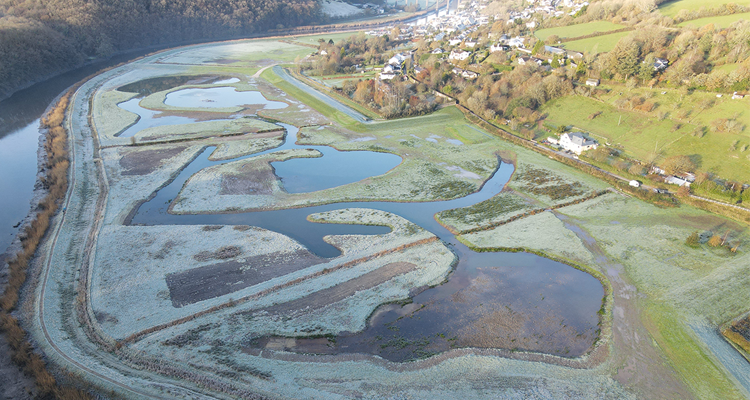Land & Water is a UK leader in environmentally conscious civil engineering
For over 40 years, Land & Water (L&W) has specialized in coastal and inland waterway civil engineering, or projects where the land and water meet. Throughout this period, it has grown to be recognized as a truly environmental organization, as a result of its diverse and creative approach to problem solving, with solutions that inherently lean towards sustainability, innovation, and an overall sense of responsibility. James Maclean, Chief Executive Officer, sits down with Construction and Civil Engineering for the first time in almost four years, to update us on how L&W has been working to sustain the sensitive habitats it operates within with its engineering expertise.
“Since 2019, we have been lucky enough to benefit from our two most successful years ever in 2021 and 2022,” James begins. “Under the Thames Tideway scheme, we have moved over two million tonnes of recycled material down to Rainham Marshes by barge where we are building London’s largest wildlife habitat. Besides dredging a number of berths and accommodation facilities for Tideway, we also removed the tunnel spoils from its tunnel drives and shafts during the construction process. All of which we have reused at our Rainham facility, which comprised two 14-month-long campaigns that required us to discharge barges 24 hours a day, seven days a week.

“The habitat creation scheme at Rainham relies solely on the reuse of beneficial recycled materials. We are hopeful of a new environmental permit later this year that will allow us to rework some of the historically placed materials at the site, given its history as a dredgings deposition site. If so, we will be able to recover substantial quantities of sustainable aggregates which we will market back into the London construction sector. We are also utilising cohesive soils in the wetlands build for migratory birds, as we are actually operating within a Site of Special Scientific Interest. The entire operation has been a real collaborative effort alongside Natural England, RSPB, The Port of London Authority, and a series of local stakeholders.
“It’s really exciting, even though we’re still working on the site, we’ve already got wading birds arriving in the newly constructed areas surrounding us,” James continues. “The range of endangered and interesting species that have been spotted has been of huge interest for the RSPB, and it’s a strange kind of paradox to witness. Nature is colonising something that we are developing for “her”, rather than fleeing from a habitat that human intervention is destroying. In addition to the two muck-away contracts we have already delivered, we have been chosen to decommission two of Tideway’s large cofferdams. The recoverable steel and aggregates from these £13m projects will be delivered to Rainham entirely by water, without adding trucks to the congested roads of the inner City.
Eliminating waste
L&W has also been using the post-COVID era to focus on accountability and the personal “responsibilities of our staff”, something that James cites as being a real societal concern. The company has established a campaign across its sites to underline the severity of employees’ time wastage during working hours, and the resultant affect it has on the organization’s efficiency and carbon footprint. The campaign was inspired by analysis comparing the average 0.93 per cent profit margin of the UK’s top 20 contractors in 2020, against research papers looking at the average wastage of the UK’s construction industry, at 35 per cent, James and his team found a striking correlation.

“The lightbulb moment for everyone, was that our time and performance contribute to a development’s wastage factor,” James explains. “If you use your time sensibly, you can reduce site wastage and therefore carbon, whilst driving profits up. The circular principle of employees being carbon inflictors is an interesting concept that has gained a lot of traction around the group, driving out wastage and increasing yield is a simple concept, but not one the industry seems to want to address head-on. I think it’s our “responsibility” to do so. A number of my operators have devised new ways to improve
efficiencies by viewing their surroundings from this new perspective, which I wholeheartedly celebrate. Carbon and accountability sit alongside one another, and this culture of wasting resources (human, materials, and time) and throwing things away is ridiculous, it has to stop.”
In applying this no-waste mentality externally, Simon Greenaway, Associate Director of Procurement, has recently returned to L&W and has been working on a new initiative to reduce the size of the company’s supply chain. By linking its subcontractors and vendors together, the organization hopes to extend its benefits and custom to both parties respectively, in an aim to give more to the people that support it the most.
Climate resilience
“I would say that the biggest challenge ahead will be helping people on their journey to accepting their own responsibility,” James concludes. “It’s not so much of an issue at L&W, but more in society and especially the construction industry, it’s terrible. I spend a lot of my working week developing our culture, values, and boundaries, because I believe that’s the way to preserve the elements of our business that people enjoy the most. This, and strategic thinking: where we are going, understanding legislation, and trying to work alongside government stakeholders, these are the factors that will shape the company going forward.
“I think the long-term modal shift in conventional construction will need to shift towards the re-purposing of existing buildings and material reuse, not just the high-carbon concept of ‘tear it down and build anew.’ As we are attempting to accommodate an ever-increasing population, we are seeing significant growth in infrastructure based in and around water. Our interest is focusing on the implications of the conspiring factors of population growth and climate change and the structural resilience our infrastructure will require in the future. We are more than just a contractor or plant hirer, L&W is here to enable part of the national strategy for nature recovery, alongside climate resilience as it’s a key agenda that has to be addressed sooner rather than later.
